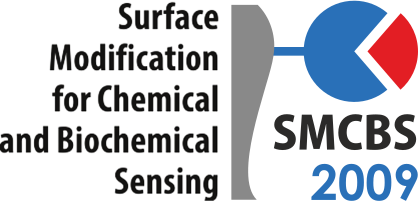4th International Workshop on Surface Modification for Chemical and Biochemical Sensing
About
Interdisciplinary permeation of concepts between chemistry, biology, physics, materials science, microelectronics, and engineering has inspired important new ideas in several research fields including sensing and biosensing. For sensing, surfaces of solid substrates, used for constructing chemical or biochemical sensors, are modified to achieve selective or, in some cases, even specific analyte detection.
The use of sensor-based analytical procedures, originally focused on chemical and biochemical tests, is gaining increasing interest, among others, in environmental toxicity testing, for ecosystem monitoring, clinical diagnosis and therapy, as well as testing of crops and foods of animal origin.
A continueous increase of interest in sensor-based techniques is manifested by the increase of the number of both scientific papers published and patents registered. Toward this interest, a series of our Workshops is organized. Being encouraged by success of the first three International Workshops on Surface Modification for Chemical and Biochemical Sensing held in 2003, 2005 and 2007, the organizers are hoping that also the fourth coming SMCBS'2009 Workshop will successfully become a platform for researchers to meet for discussing in-depth, exchange and generate ideas that will stimulate new, and most expectantly, collaborative research.
Apparently, electrochemical aspects of chemical and biochemical sensing dominated former Workshops and most participants were either committed to electroanalytical chemistry or used electroanalytical techniques.
As previously, the present Workshop will be focused on the art of both chemical and non-chemical decorating of solid transducer surfaces as well as recognition activity of the resulting sensors toward target analytes. Main topics of the Workshop will cover various aspects of surface chemistry related to sensing and biosensing in solutions or gases but are not limited to:
- Chemical surface reactions
- Self-assembled monolayers (SAMs)
- Langmuir and Langmuir-Blodgett (LB) films
- Preparation and properties of supported thin films
- Chemically modified electrodes and polymer modified electrodes
- Enzyme modified electrodes in particular
- Novel techniques and instrumentation for examining surfaces
- Signal transduction and processing, detection techniques and protocols, system miniaturization and nanotechnology use
All participants will be accommodated at one Workshop site. Therefore, the number of participants is limited by its capacity. This way of accommodation facilitates mutual contacts, both formal and informal, enabling discussions to be continued far beyond the program.
Particularly, young researchers, i.e., graduate students, post-doctoral fellows and research assistants, are welcome to contribute their enthusiasm and ideas to stimulate the field of chemical and biochemical sensing. All presentations, and particularly those of young researchers, will be widely discussed within the audience while constructive input of senior scientists is anticipated.
A half-day sightseeing excursion will bring participants closer together for better personal acquaintance and ad hoc discussions in small groups.
We cordially invite you to participate in the Workshop.
Włodzimierz Kutner and Marcin Opałło

